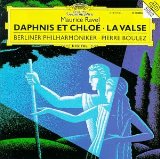Daphnis et Chloe
An Exquisite, Hypnotic Ballet
Ravel's magnificent masterpiece Daphnis et Chloe depicts an ancient pastoral love story. Explore this sumptuous masterpiece here...
Ravel described Daphnis et Chloe as a "choreographic symphony in three parts". The rich, sensual, and hypnotic sound-world Ravel creates is the perfect example of Impressionist music.
It was commissioned by the famous Sergei Diaghilev (director of the ballet company the Ballets Russes) in 1909. Ravel was excited by the idea, but it took him three years to finish the entire piece!
Diaghilev was a bit annoyed, since he thought that it was more "symphonic" than "choreographic". The 1912 premiere was lukewarm, since it was overshadowed by the shocking innovations of Igor Stravinsky at the time.
Nowadays the piece is very popular, especially in its concert versions.

The Sumptuous Music
The ballet is just under an hour, making it the longest of Ravel's pieces. It's definitely one of his most complex and characteristic as well. Its highly-crafted and romantic sound is typical Ravel.
It's based on an ancient greek fable by Longus about the shepherd and sherpherdess Daphnis and Chloe.
The two were abandoned young, and raised together by simple and pleasant shepherds. They fall in love, but Chloe gets abducted by pirates. She's saved by the god Pan, and her and Daphnis sacrifice two sheep as an offering for their union.
The composer wanted to recreate the peaceful, beautiful ancient Greece of his imagination.
I think he definitely managed to achieve this... the music in Daphnis et Chloe is stunning!
It has exquisite orchestration, amazing melodies, and luxurious passages which conjure up images of nostalgic pastoral bliss.
It uses a massive orchestra, which includes a gong, a wind-machine, and an offstage choir! Ravel also divided each string group into two, making 10 parts instead of the normal 5. This creates an unusually rich-sounding base for the rest of the orchestra to layer on top of.
Ravel took music from his "choreographic symphony" to create two orchestral suites (the choir is optional for these).
The extremely well-known second suite is actually just the entire third act with a few adjustments.
Here are some video clips of parts of the music. The first is the mesmerizing beginning of Act III (also the beginning of the second suite), depicting dawn in a forest grotto.
This second clip is from the very end of the ballet, where the shepherds are celebrating the marriage of Daphnis and Chloe:
Good Recordings
Now, on to the recordings!
Charles Munch conducting the Boston Symphony Orchestra is a classic performance of the complete ballet, recorded in the 50s. It's a passionate interpretation, with a very well-balanced recording sound.
Personally, I prefer exceptionally clear recordings of the ballet (since it's so rich and complex), which usually means the more modern ones.
Some of these can sound quite rough though, especially in the sections which have percussion in them (the piece has 15 different percussion instruments!).
One in particular which I really enjoy is the amazing sound of the Pierre Boulez/Berlin Philharmonic recording.
The colors are astonishingly vivid, and everything is sweet and light. In fact, I'd say that you haven't experienced Daphnis and Chloe properly unless you've heard this recording!
You'll probably also enjoy Ravel's touching musical elegy Le Tombeau de Couperin, or his beautifully devilish piano masterwork Gaspard de la Nuit.
If you like my site, please click "Like"... thanks!



